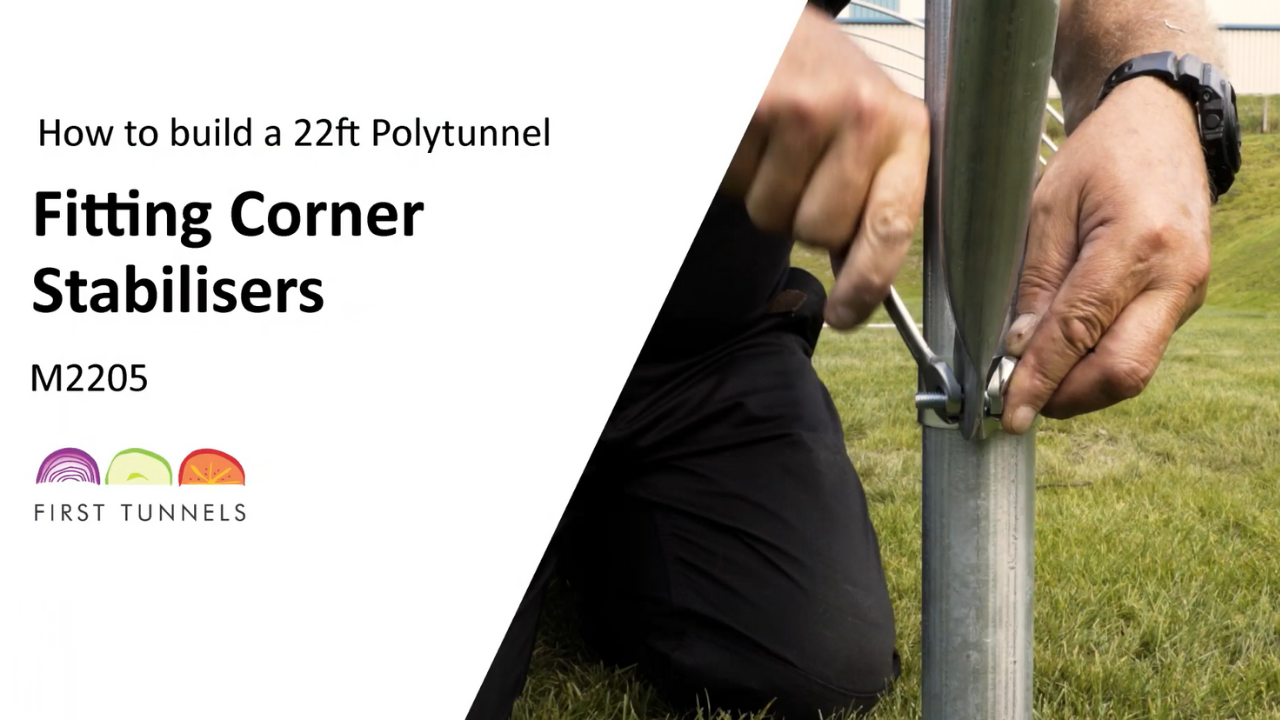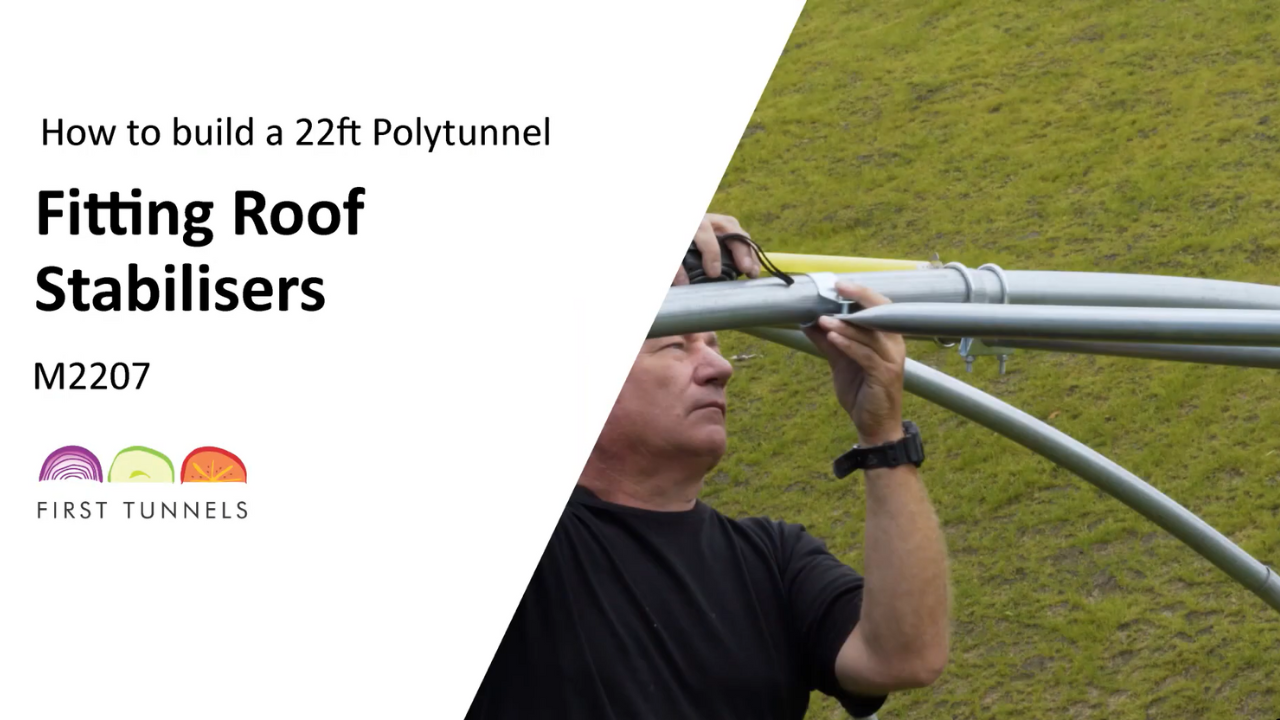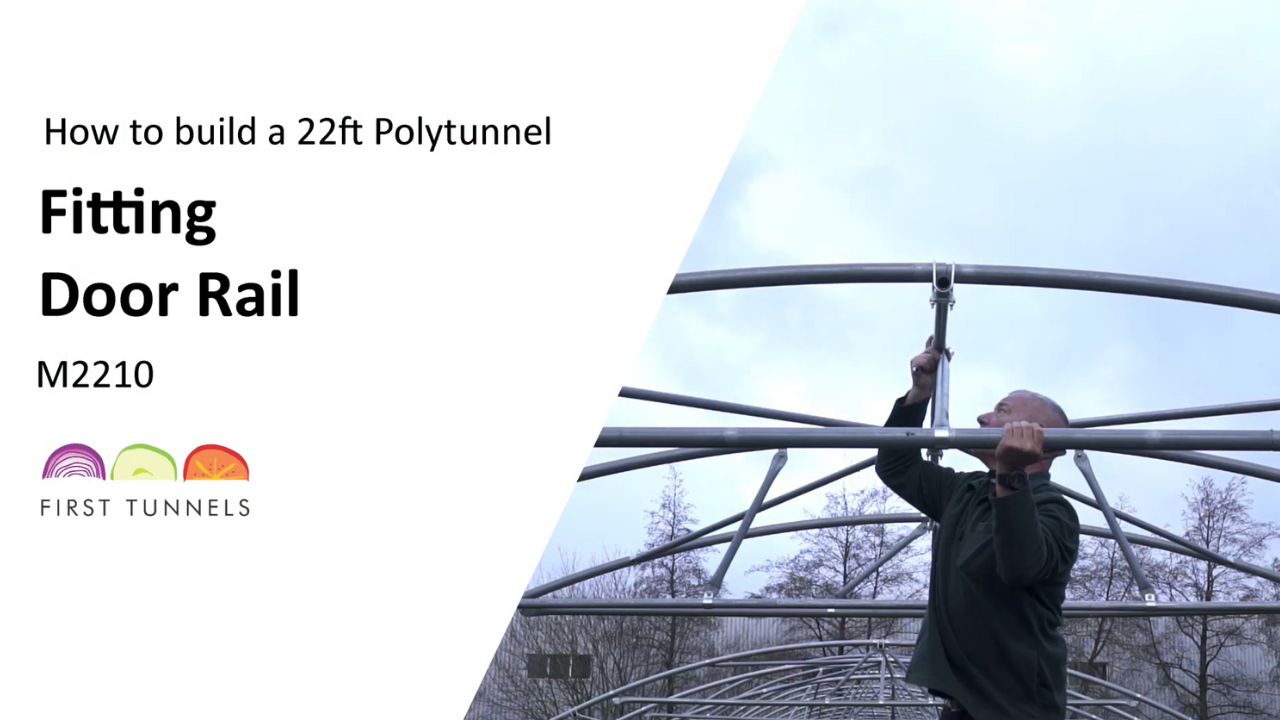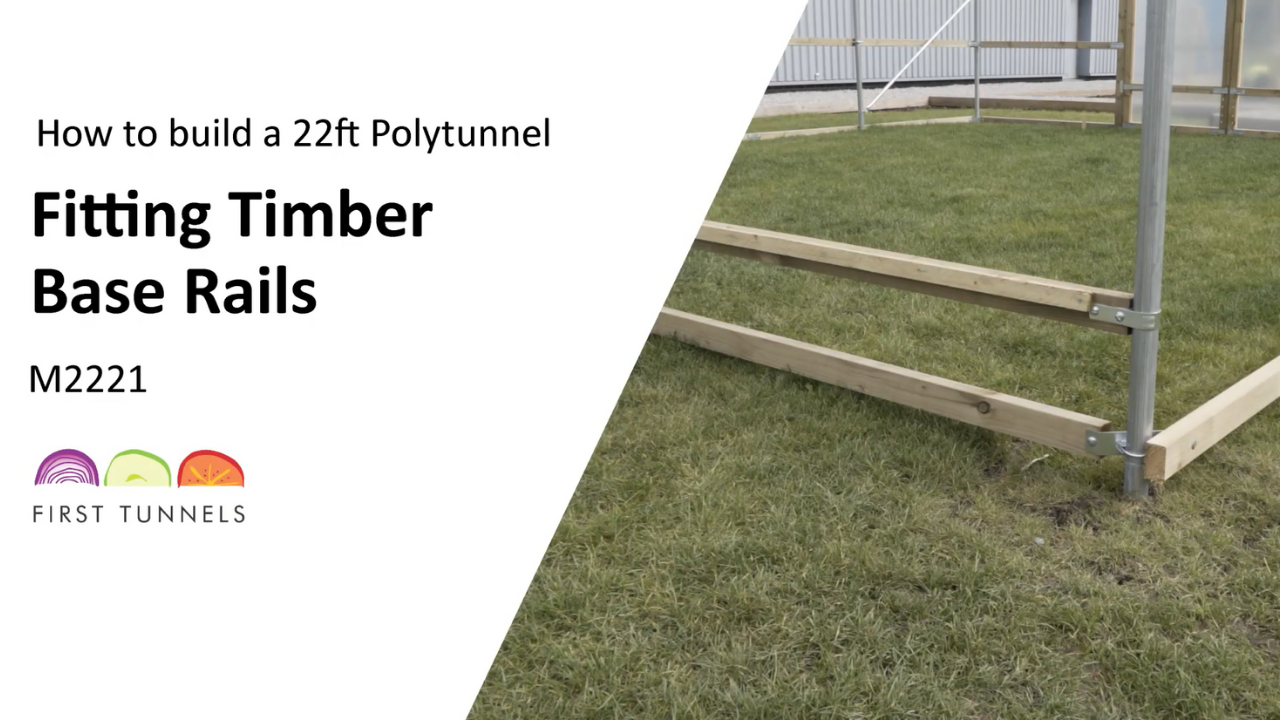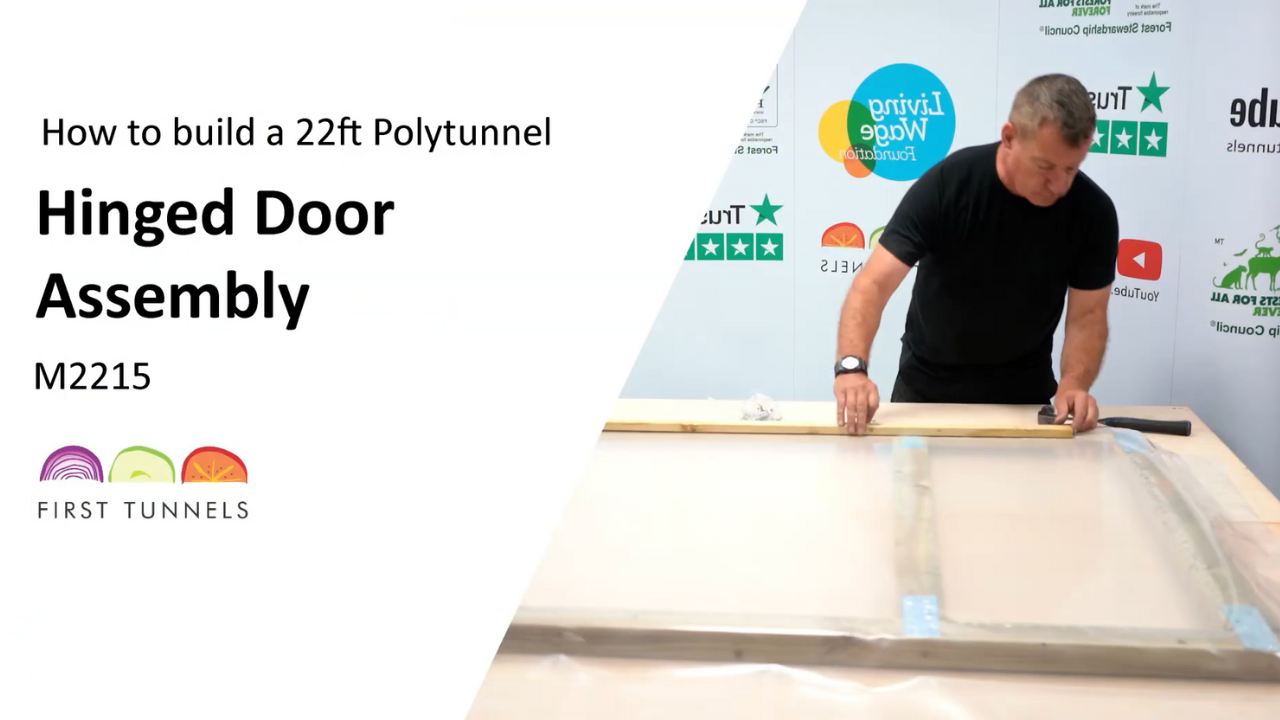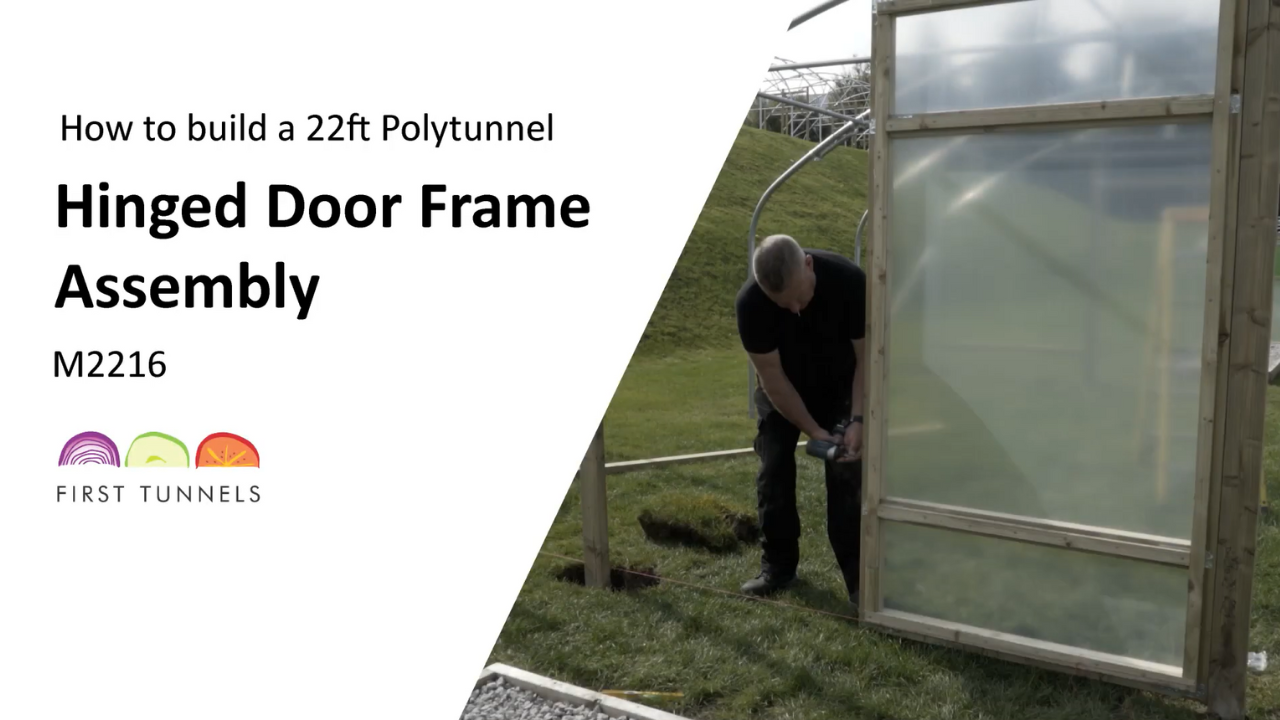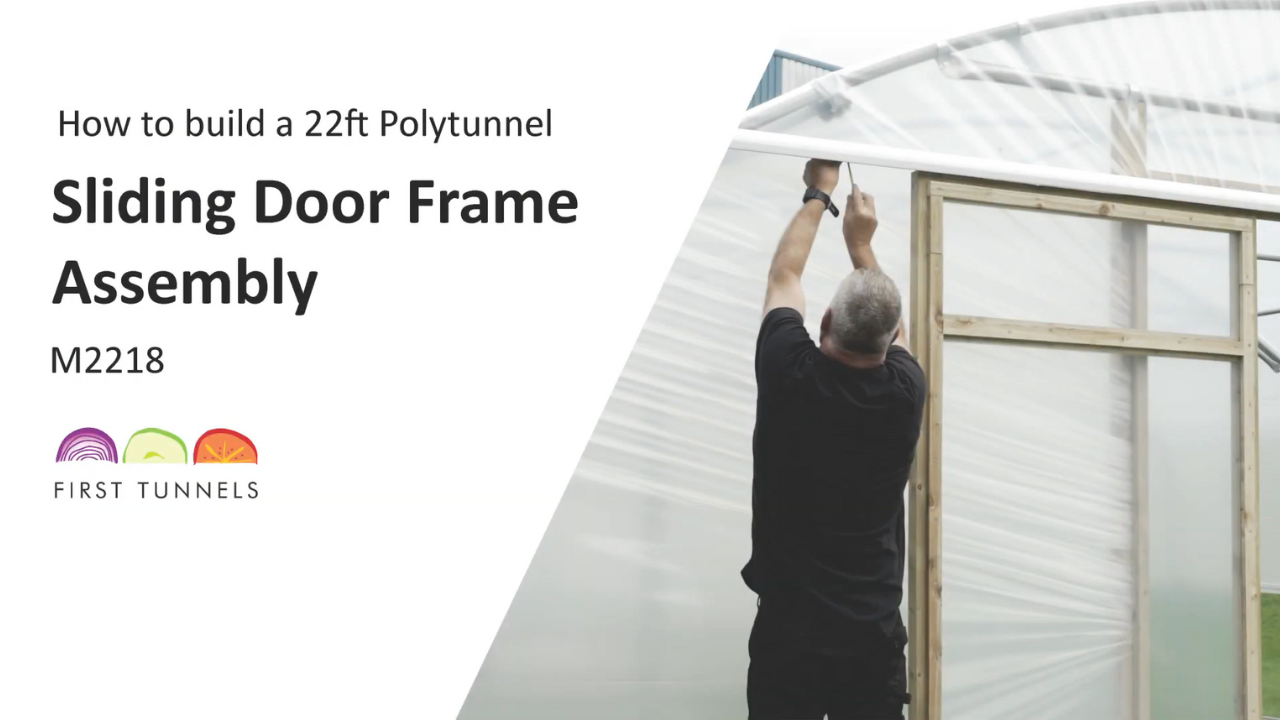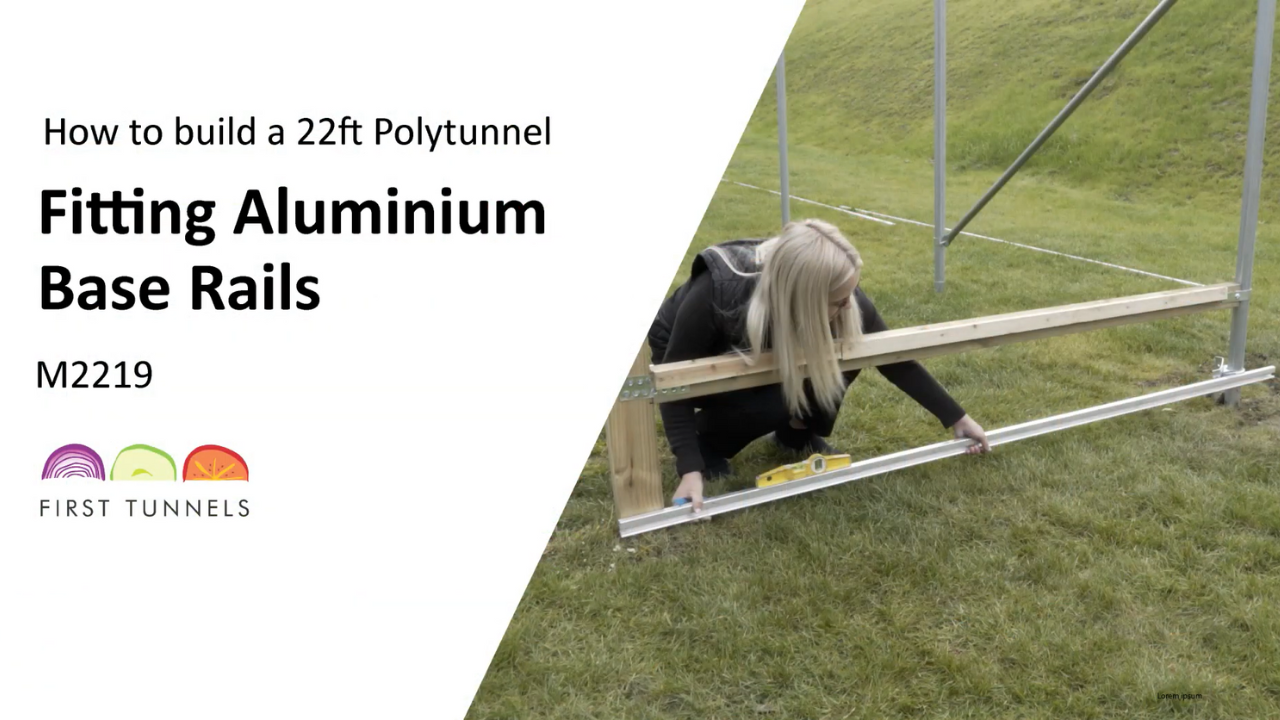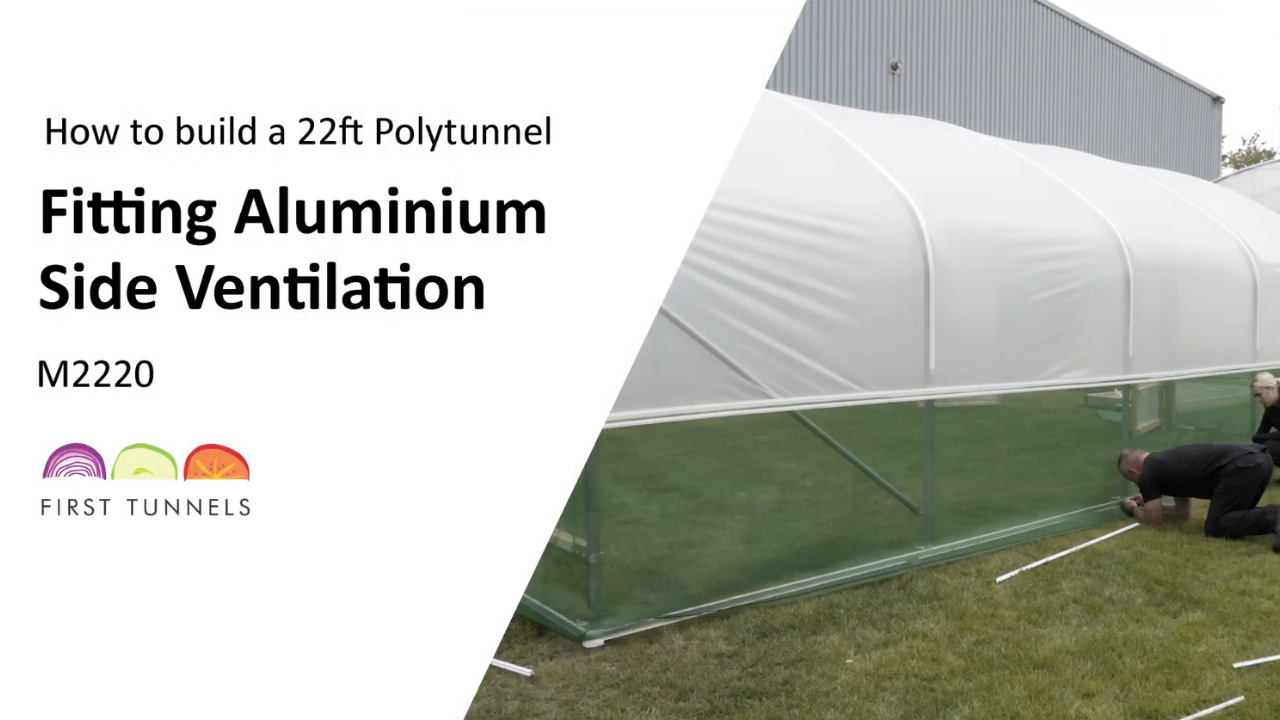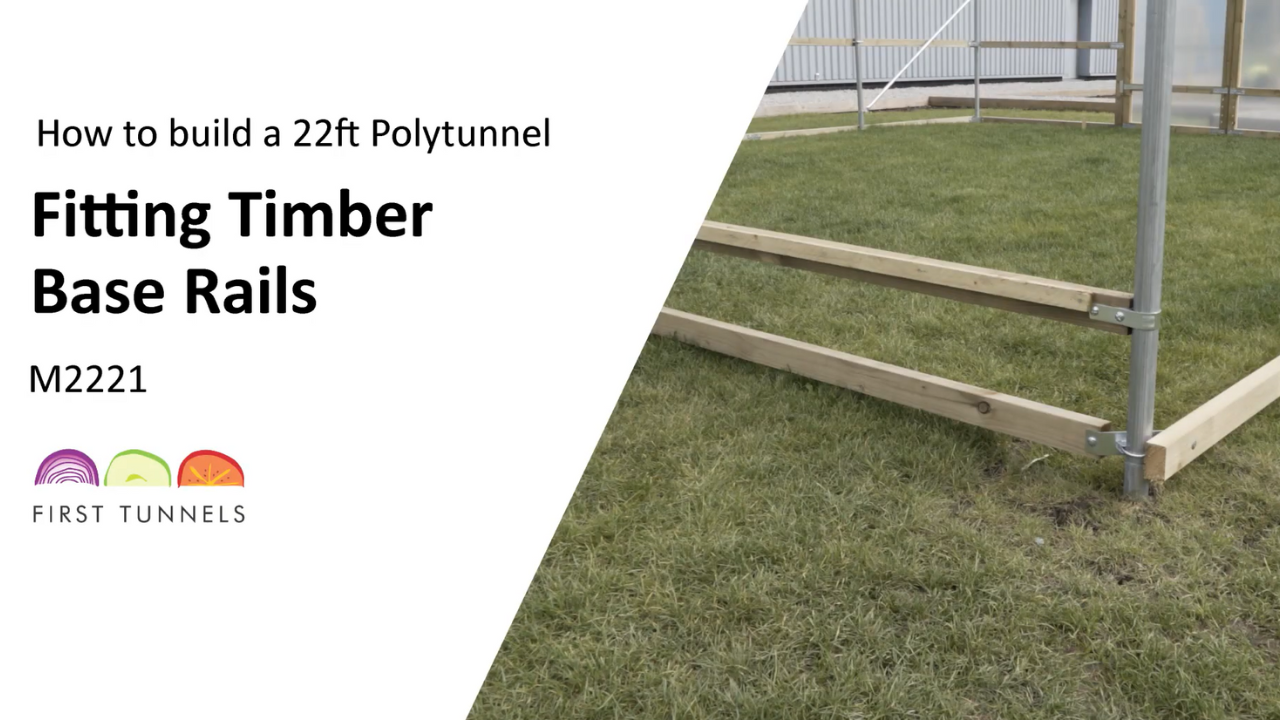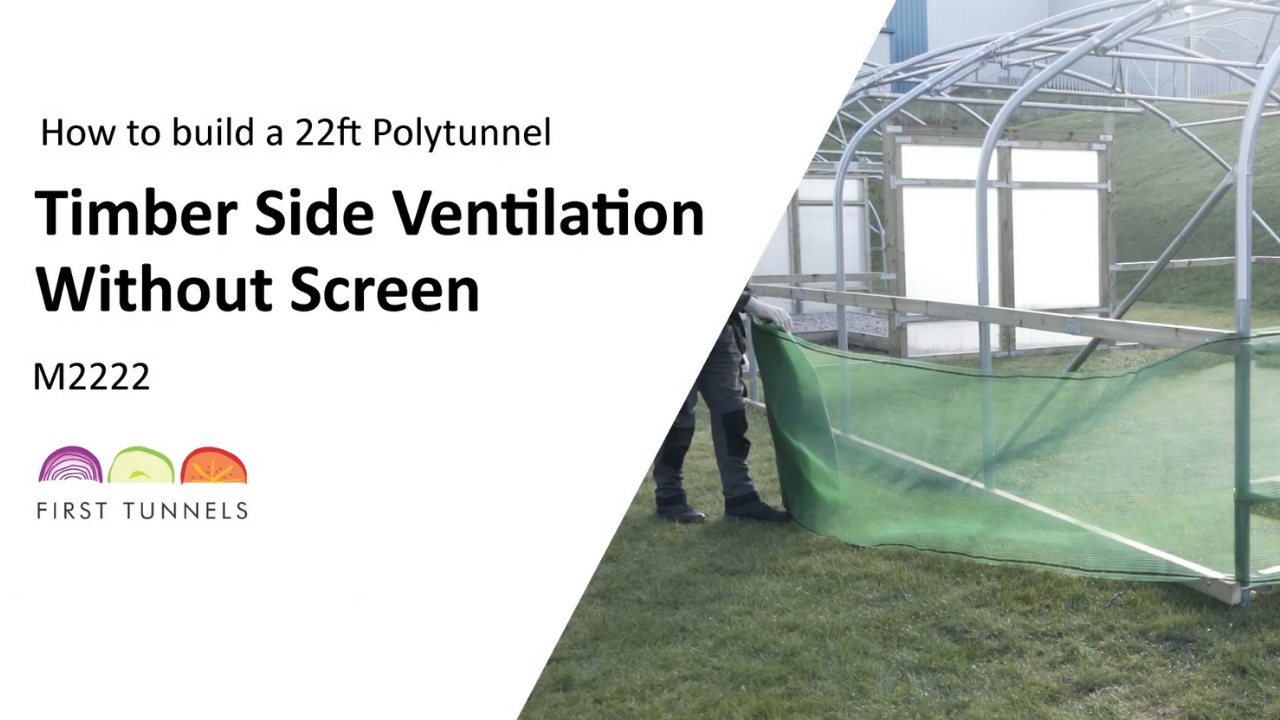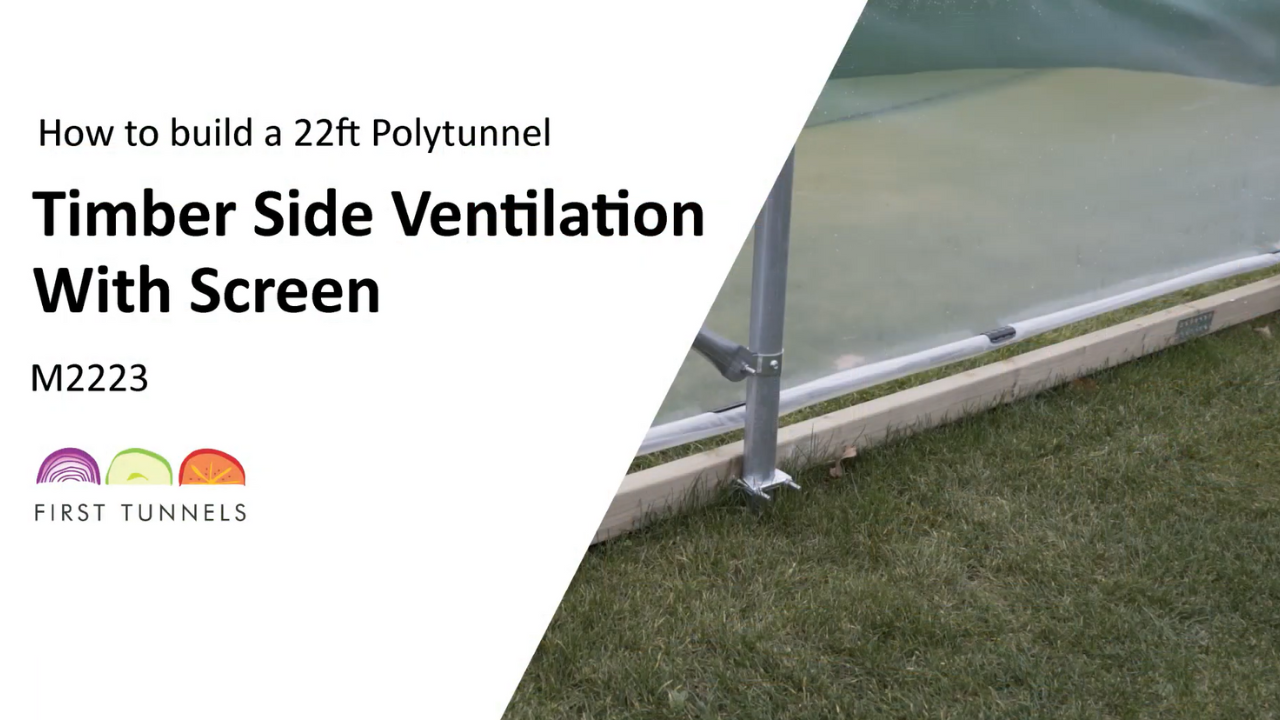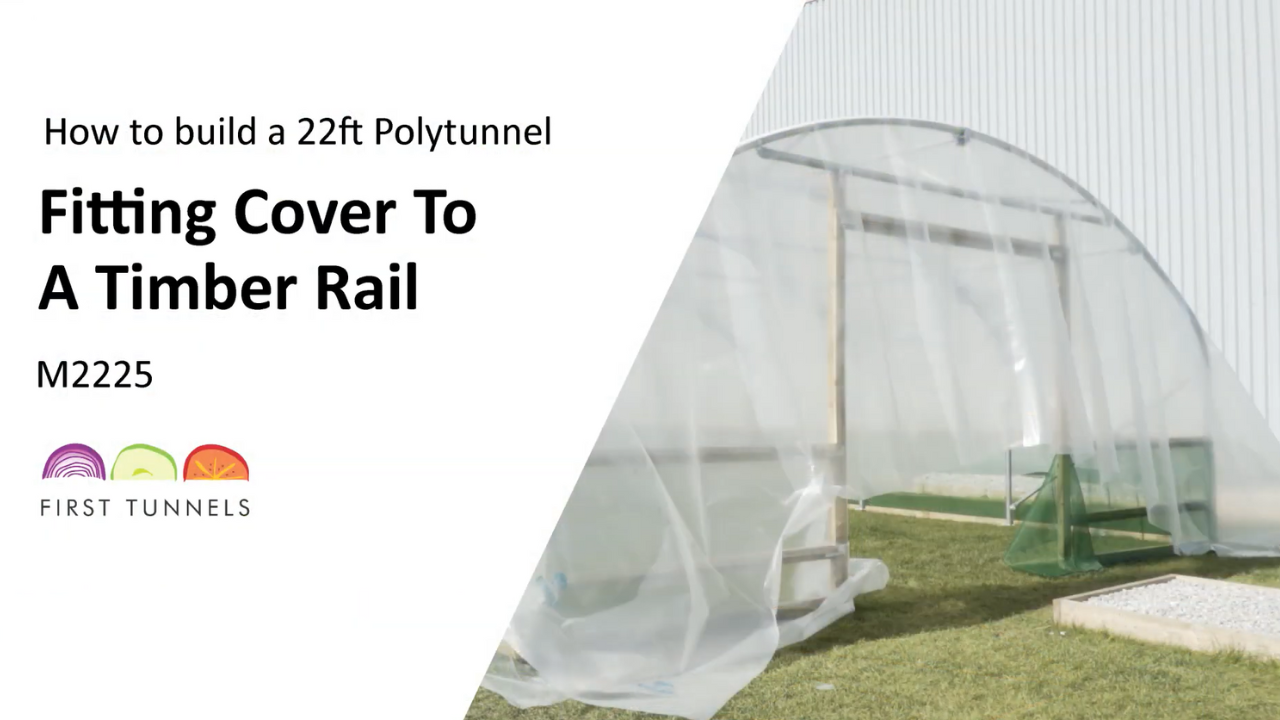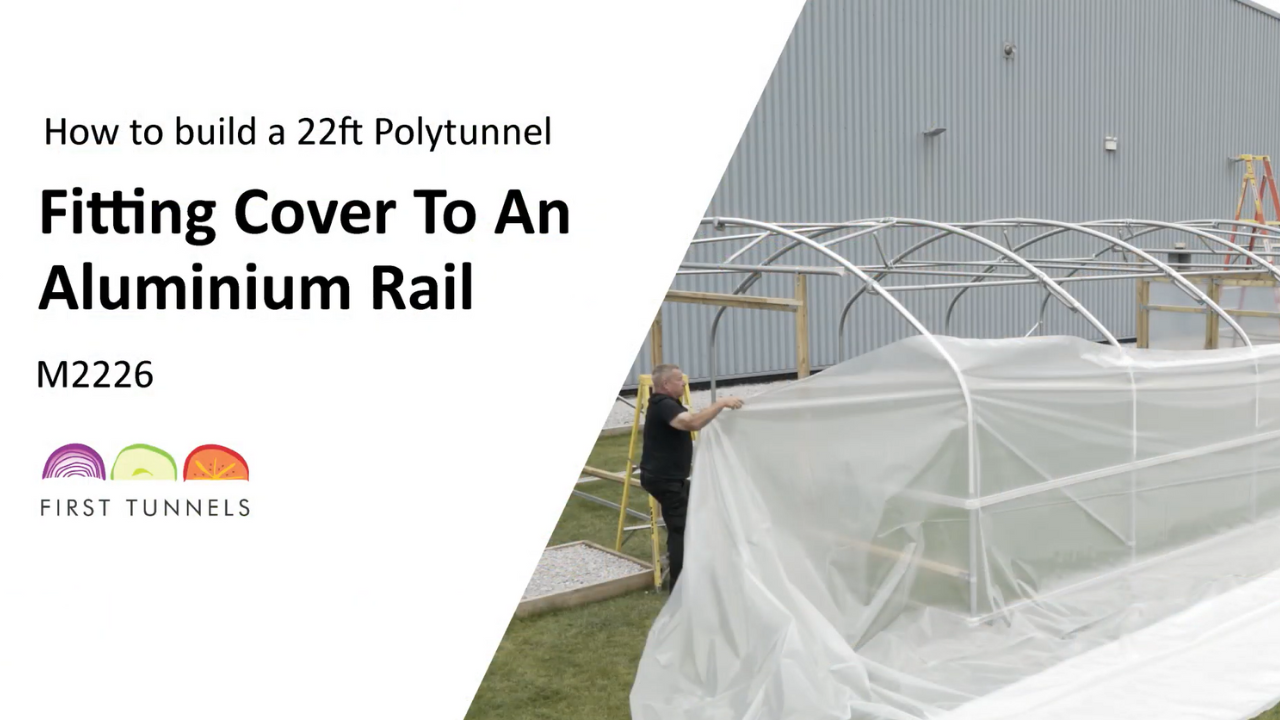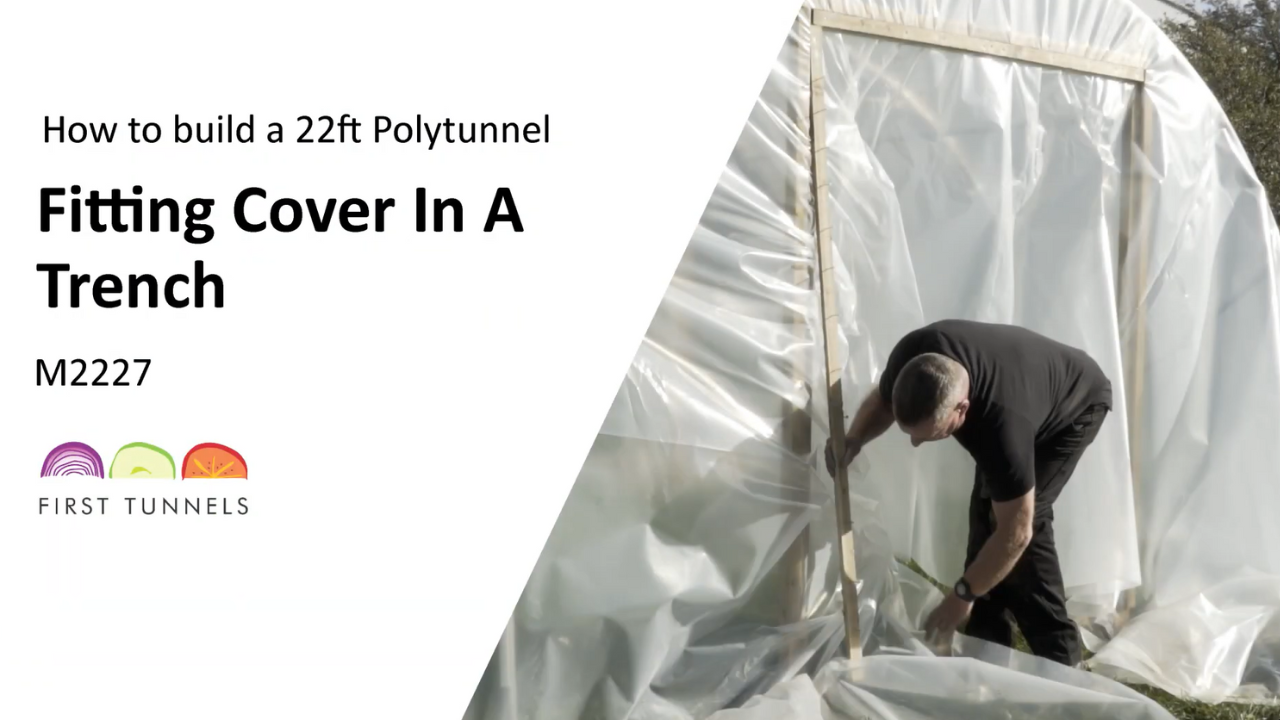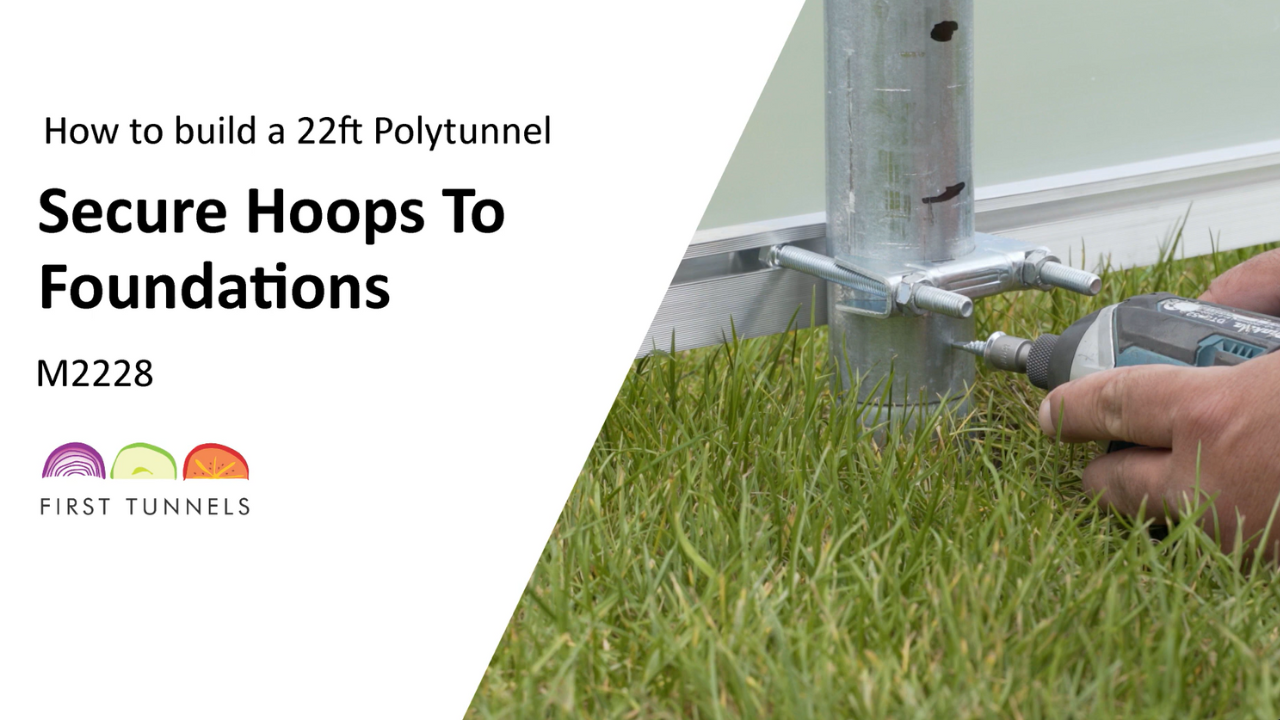The door frame (CODF) comprises of 3 pieces of 100mm x 47mm x 3m timber which are the two door frame posts and one door frame lintel. The remaining pieces supplied in the pack are 19mm x 38mm x 1.8m battens which are used later when fitting your polytunnel cover.
Run a taut string line across the width of your polytunnel on the end hoop across the front of the hoop. You will use this string line to make sure your door frame is flush with the end hoop. Determine the centre of your polytunnel width by measuring 10ft from the corner hoop from the centre of the tube. From this central position, measure 1.14m towards each corner hoop (fig 16a).This identifies the position of your door post. If you are fitting your polytunnel onto an earth base you will be required to excavate a hole 30cm square and 40cm deep. If fitting to a solid base such as concrete or timber the door frame posts will be secured to the ground using brackets.
Reposition the door frame post into the hole or onto the solid base ensuring the front face of the post is behind the string line. Ensure the door frame post is positioned 1.14m from the centre mark to the outside of the door frame post. Use a spirit level to ensure the door post is vertically level, mark where the door post meets the door rail and cut the post on this mark (fig 16b). Reposition the door post. Position a P clip (P50) onto the hoop. Both prongs of the P Clip (P50) should then run down the front (outer) face of the door post where it is held in place with bolts (fig 16c).Make a mark through two holes of the P clip then drill a 9mm hole through these marks. Push a bolt through the P clip and drilled holes so that the thread is on the inside of the polytunnel, fit the washer and screw on a nut then tighten. Adjust your door frame post so that the front face touches the string line and the outer edge of the door frame post is 1.14m from the centre and it is vertically level. Once you are happy with the position tighten the nuts on the P clip and secure the P clip in place with a self-drilling screw (SDS55).
If on soil, backfill the hole with concrete. We suggest using concrete that is 1 part cement and 5 part aggregate. We also recommend ‘PostCrete’. This ready-made mix is supplied in 20kg bags, requires no mixing, you simply add water. Approximately one bag per hole will be required. If on a solid base, fix the base of the plate to the floor using Shield Anchors for concrete or Coach Screws for timber. Position the door frame post plate on the ground on the inside of your polytunnel, make a mark through the centre hole then remove.
If on a concrete base drill a hole 8cm deep using a 16mm masonry drill bit. Separate the bolt and washer from the sleeve and insert through the hole in the door frame post plate and then screw on the sleeve (fig 16d). Locate the shield anchor into the hole and firmly tighten using a 17mm spanner. If on a timber base drill a pilot hole 7cm deep using a 9mm timber drill bit. Reposition the post plate and tighten the coach screw using a 17mm spanner. Finally, screw the plate to the door post using the screws provided (fig 16e). Repeat this process for the second door post.
You will be required to cut the door frame lintel so that it fits between the door posts. The door frame lintel should be at the height of 2.1m from the ground to the bottom edge of the lintel. Measure up one door post 2.1m, if your site slopes across the width, measure up the post on the higher side. Offer the door frame lintel up, position one end flush with one door post and make a mark at the other end and cut. Reposition the lintel, ensure the door fame lintel is level and use a 4mm wood drill bit to drill a pilot hole (fig 16f). Use a 150mm screw to secure to the door post (fig 16g). Repeat at the other side. The joints can now be reinforced with nail plates on both sides (fig 16h). Position a nail plate equally across the joint and secure in place with twisted nails.
Sliding door support rails are fitted between the door post and corner hoop to support the sliding door. Sliding door support rails are 47mm x 75mm timber and come in lengths of 2.4m which will need cutting to size. From the ground, measure up the door post 30cm and make a mark. Position a piece of timber flush with the door post and horizontally level and cut the piece of timber to fit between the door post and corner hoop. Secure the support rail to the door post by drilling a pilot hole using a 4mm wood drill bit and then use a 150mm screw. The support rail is fixed to the corner hoop using a P clip supplied in the sliding door support rail fixing kit. Position a P clip onto the corner hoop with both prongs of the P Clip running along the front face of the sliding door support rail. Make a mark through the 2 holes on the P clip and then drill a hole through the timber on each mark. Reposition the P clip and secure the support rail to the P clip using the bolts and nuts provided. Ensure the support rail is level and then secure the P clip to the hoop use a self-drilling screw. Now reinforce the joints between the door post and support rail using nail plates on both sides (fig 16i).
The final step for the support rail is to fix a batten to it on the outside. The batten should be cut to fit between the end of the P clip and approximately 5mm away from the joint on the door post. You may require more than one length of batten and need to cut to size. Once the correct size, nail batten to the support rail ensuring the top edges are flush.
The process of fitting your sliding doors will be done once you have fitted your polytunnel cover. Please read the section on fitting the polytunnel cover to timber or aluminium rail or using the trenching method and then return to this section to perform the final fit of your sliding doors. For each double sliding door, the aluminium door rail track is supplied in 2 lengths of 2.40m. You will be required to join the two pieces of door track together. Join these together by inserting a rail joiner approximately half-way into the tee slot on the rear of the door track, position the second track so the ends meet. Check that the rail joiner is central and tighten all 4 grub screws with the supplied 3mm allen key (fig 16j). The door track is secured to the lower batten and the lintel using 8 bolts (fig 16k).
First measure and mark where you need to drill the holes to secure the sliding door track. Measure 10cm in from the inner edge of the door frame post. Now measure 2cm up from the bottom edge of the door frame lintel. From the bottom of the door track to the fixing channel is 2cm. The 2cm marks give a guide for your holes. Repeat on both sides. Use the door track to draw a straight line along the door frame lintel. The door track joiner will inhibit using fixing bolts within the central 20cm section. Find the central point of your door frame lintel and then measure 10cm either side to ensure you don’t position bolts there. Mark the position of the remaining holes required. Ensure they are all spaced an even distance apart. With a 9mm wood drill bit, drill the required holes. Slide 4 bolts down each end of the tee slot on the door track (fig 16l). The track should be positioned centrally and overhang evenly on both sides of the door frame (fig 16m). Align the bolts into position through the holes. Bolt into position by fitting a washer and nut. You have now fitted the sliding door track. The corners of the door track are sharp. Please ensure you fit the corner protectors to prevent any injury (fig 16l).
To eliminate the risk of damaging the polytunnel cover when the door opens and closes, battens are fixed on the inner batten of the door frame posts. A batten is also fixed directly on top of the existing batten on the sliding door support rails (fig 16n). Slide the doors onto the door track.If your doors are not correctly aligned, adjust the wheel assembly by turning clockwise or anti-clockwise.
Door stops prevent the doors from rolling out of the track. 4 door stops are provided. One for each end of the track and an additional 2 stops in the middle of the track (fig 16o). Assemble the door stop by screwing the slotted grub screw through the bracket and into the rubber stop (fig 16p). You will be required to remove one door from the track. Slide 2 door stops down the door track to the centre (fig 16q). Re-hang the second door. Close the doors so they are central to the frame and then adjust the door stops to butt up to the wheels. Slide in the outside stop and tighten the slotted grub screw. Adjust each stop by releasing, sliding along and re-tightening until the door stop is in the required position.
The door guide prevents your sliding door from swinging in the wind. Assemble the door guide by screwing on the flange nut onto the threaded rod with the flange to the top, slide on the nylon roller and secure with the locking nut (fig 16e). You will need to hold the rod with grips to hold it tight while screwing on the locking nut. Do not tighten the nut completely, allow the roller to turn. Position the door guide in line with the door frame post which the door slides past. Making sure it is upright, drive the guide into the ground (fig 16s). You will be required to repeat this process for both doors. If you have a hard base, fix a door frame post plate to the floor (fig 16t).
Door drop spikes that keep your door from blowing in the wind. Door drop spikes are fitted to the outside face of the door on the opposite side to the door opening. Measure up from the bottom of the door 9cm and make a mark (fig 16u). Position a door drop spike guide bracket so the bottom of the bracket is flush with this mark. Mark the position of the 2 slots in the bracket and across the top. Now reposition the bracket so the bottom of the bracket is flush with the top mark and mark the position of the 2 slots again. Using a 9mm wood drill bit, drill a hole through the door for the 4 slots. On the inside face of the door insert pronged T nuts into each hole. Bolt the 2 angled brackets to the door with the slot on each bracket at the top. Close the door to the required position, slide the drop spike down through both brackets and mark the position on the ground. Open the door and bury the tube in the required position (fig 16v). If your polytunnel is on a hard base the housing tube is not required. Simply drill a hole using a 9mm drill bit to an appropriate depth. Repeat this process on both doors.


